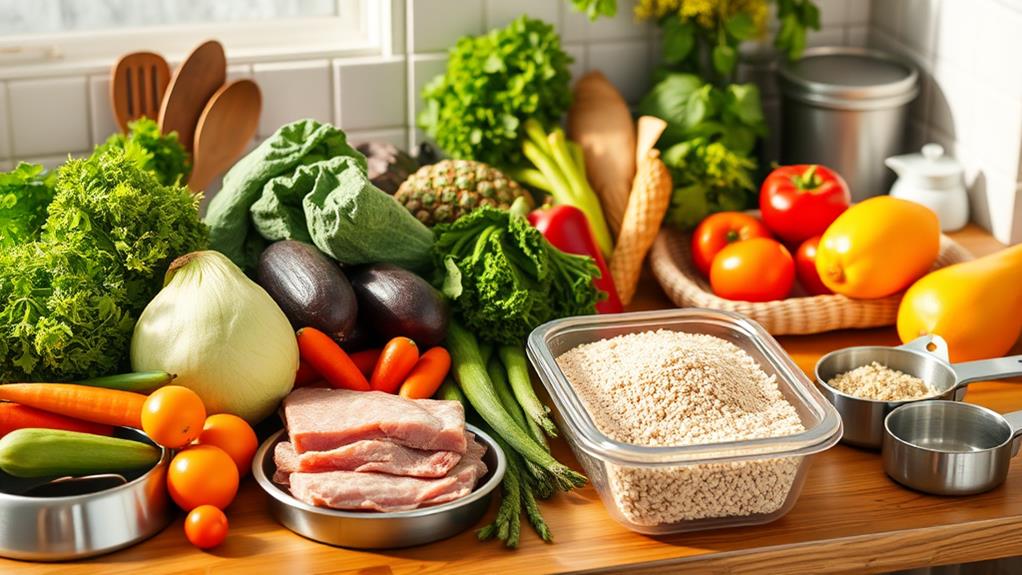Meal prepping for your dog's dietary needs guarantees they get the right nutrition. Start by understanding your dog's specific nutritional requirements based on their age, size, and activity level. Choose high-quality, fresh ingredients and measure portions accurately. Create a weekly menu that incorporates variety, including different proteins and vegetables. Batch cooking saves time, while proper storage keeps meals fresh. Always monitor for any signs of spoilage and adjust recipes to accommodate any dietary restrictions. By keeping things diverse and healthy, you can cater to your pup's taste and health. Keep exploring to discover even more practical tips!
Understand Your Dog's Nutritional Requirements
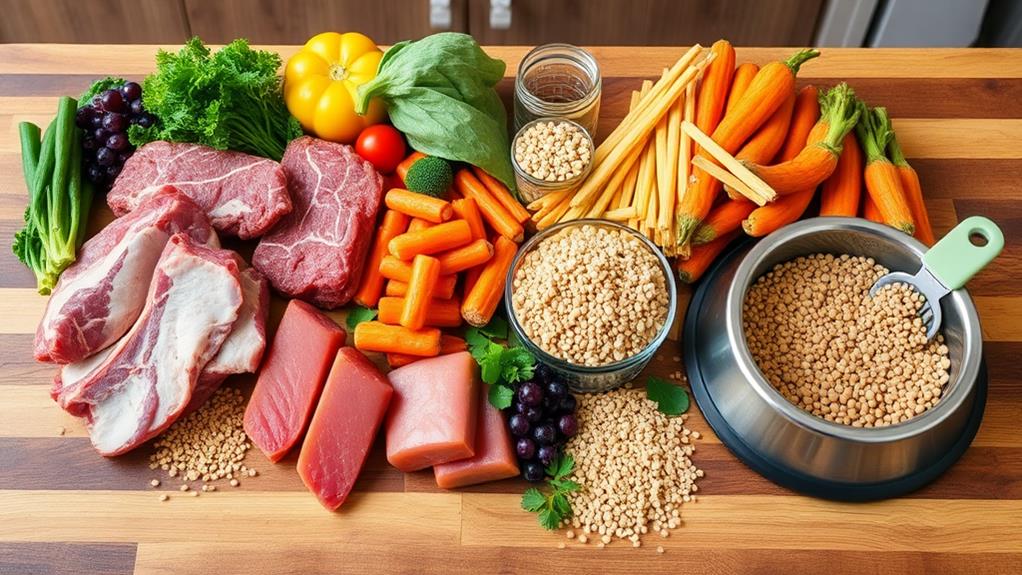
To cater to your dog's specific dietary needs, it's indispensable to understand their nutritional requirements. Dogs, like people, need a balanced diet to thrive. Start by considering the essential nutrients: proteins, fats, carbohydrates, vitamins, and minerals. Each nutrient plays a pivotal role in your dog's health and well-being.
Proteins are fundamental for building and repairing tissues, while fats provide energy and support cell function. Carbohydrates offer a quick energy source, though they should be included in moderation. Don't forget about vitamins and minerals; these micronutrients help maintain a healthy immune system and support overall bodily functions.
Additionally, consider your dog's age, size, breed, and activity level when determining their nutritional needs. Puppies require more protein and calories for growth, while older dogs may need fewer calories to maintain a healthy weight. A working dog may need more energy compared to a sedentary pet.
To guarantee your dog receives the right nutrients, consult your veterinarian. They can help guide you in creating a balanced meal plan tailored to your dog's specific needs. Understanding these requirements is the first step in meal prepping effectively for your furry friend.
Choose Quality Ingredients
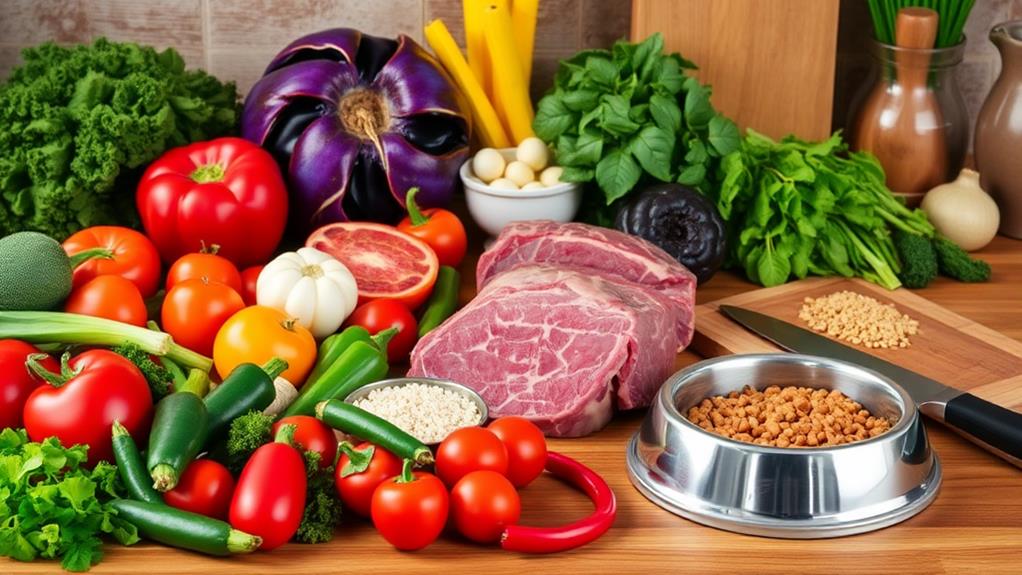
Choosing quality ingredients is essential for your dog's health and happiness. When you prepare meals for your furry friend, focus on fresh, whole foods that provide the necessary nutrients. Look for high-quality proteins like lean meats, fish, and eggs, which are crucial for muscle development and overall vitality.
Don't forget about vegetables! Incorporating a variety of colorful veggies can offer a range of vitamins and minerals. Sweet potatoes, carrots, and spinach are great options that many dogs enjoy. Additionally, consider adding healthy fats like fish oil or coconut oil, which promote a shiny coat and improve joint health.
When shopping, read labels carefully. Avoid products with fillers, artificial additives, or preservatives. These can lead to digestive issues and may not provide the nutrition your dog needs. Instead, opt for brands that use whole ingredients and are transparent about their sourcing.
If you're unsure about specific ingredients, consult your veterinarian. They can guide you on what's best for your dog's unique dietary needs. By prioritizing quality ingredients, you're setting your dog up for a healthier, happier life.
Plan Balanced Meal Portions
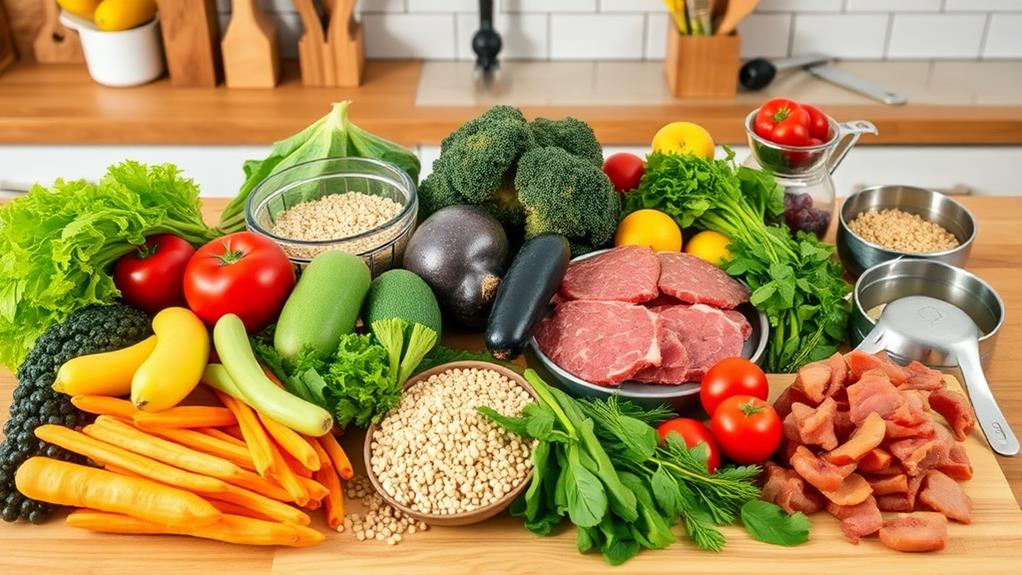
Once you've selected high-quality ingredients for your dog's meals, it's time to focus on planning balanced meal portions. A well-balanced meal guarantees your dog gets all the essential nutrients they need to thrive. Start by determining your dog's ideal daily caloric intake based on their age, weight, activity level, and breed. You can consult your veterinarian for specific recommendations.
Next, break down this caloric intake into appropriate meal portions. For most dogs, splitting their daily food into two or three meals is ideal. Measure out the food using a scale or measuring cup to establish consistency. Remember, each ingredient contributes differently to your dog's diet, so pay attention to protein sources, carbohydrates, and healthy fats.
Incorporate a variety of fruits and vegetables to enhance nutrient diversity while keeping the portions balanced. Avoid overloading any one meal with too much food; instead, distribute the ingredients evenly across the meals. This not only helps with digestion but also keeps your dog satisfied throughout the day. By planning balanced meal portions, you'll help maintain your dog's overall health and well-being.
Create a Weekly Menu
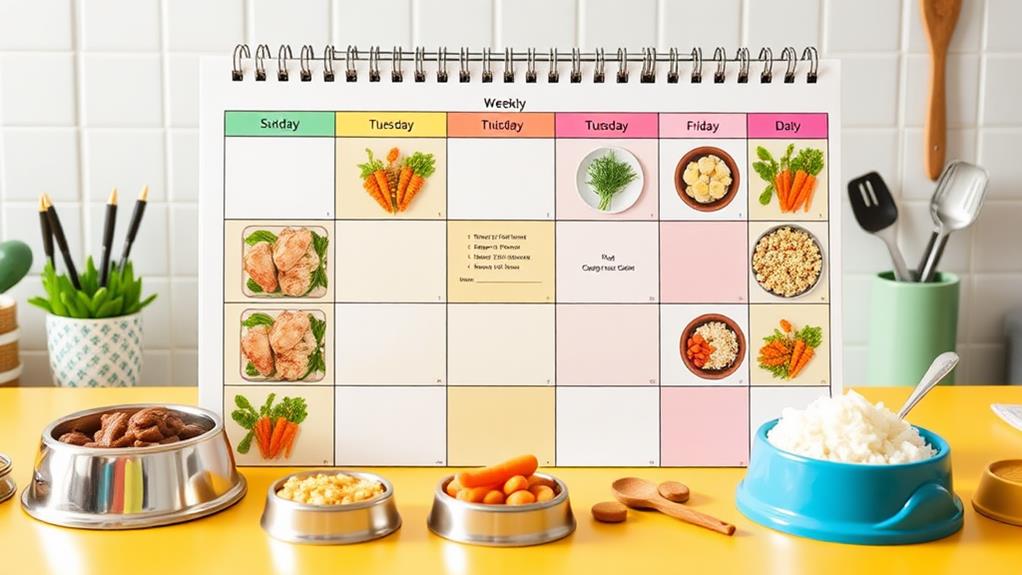
Creating a weekly menu for your dog can simplify meal prepping and ascertain your furry friend gets a variety of nutrients throughout the week. By planning ahead, you can verify your dog enjoys balanced meals that cater to their specific dietary needs.
- Choose Protein Sources: Rotate between different proteins like chicken, beef, fish, and turkey. This variety keeps meals interesting and provides essential amino acids.
- Include Vegetables: Add a range of dog-friendly vegetables such as carrots, green beans, and sweet potatoes. They're packed with vitamins and fiber.
- Select Carbohydrates: Incorporate healthy carbs like brown rice or quinoa for energy. These should complement the protein and vegetables in each meal.
- Consider Supplements: If necessary, add supplements to meet specific nutritional needs. Consult your vet for recommendations tailored to your dog's health.
Batch Cook Efficiently
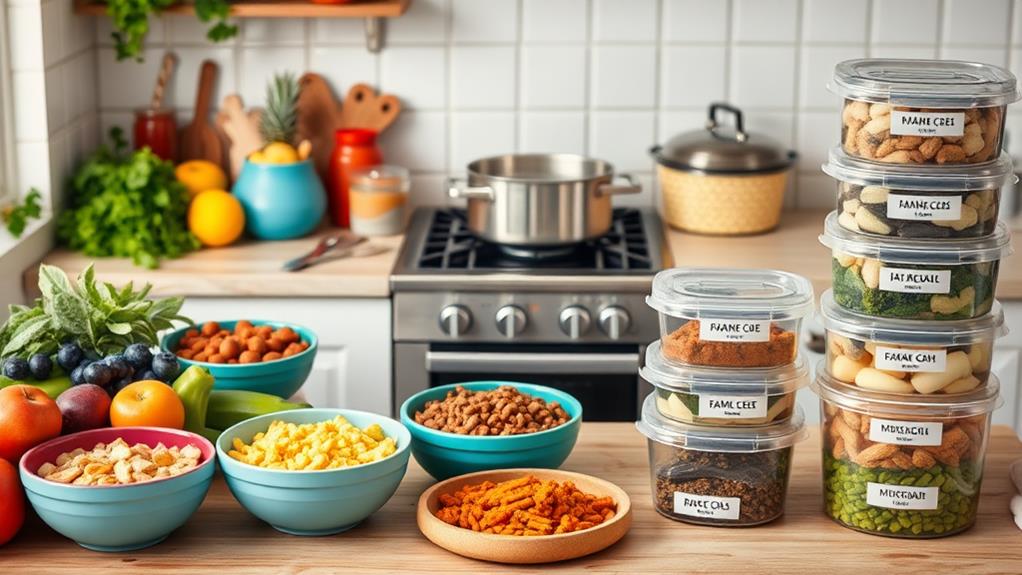
With your weekly menu in hand, it's time to focus on how to batch cook efficiently. First, gather all your ingredients and tools before you start. This way, you won't waste time searching for things mid-cook. Chop vegetables, measure grains, and portion proteins in advance. It'll streamline the process and help you stay organized.
Next, use large pots and pans to maximize your cooking capacity. For example, if you're boiling chicken or simmering rice, do it in bulk. This not only saves time but also energy, allowing you to prepare multiple meals at once. Don't forget to use your oven for roasting veggies or baking treats; it can handle larger quantities than stovetop cooking.
Consider investing in a slow cooker or pressure cooker, as these appliances can substantially reduce cooking time while enhancing flavors. Once everything is cooked, you can mix and match different ingredients to create variety in your dog's meals, making it easier to keep their diet interesting.
Lastly, clean as you go. It'll make the process smoother, and you won't feel overwhelmed by a pile of dishes at the end. With these tips, you'll master the art of batch cooking for your furry friend!
Store Meals Properly
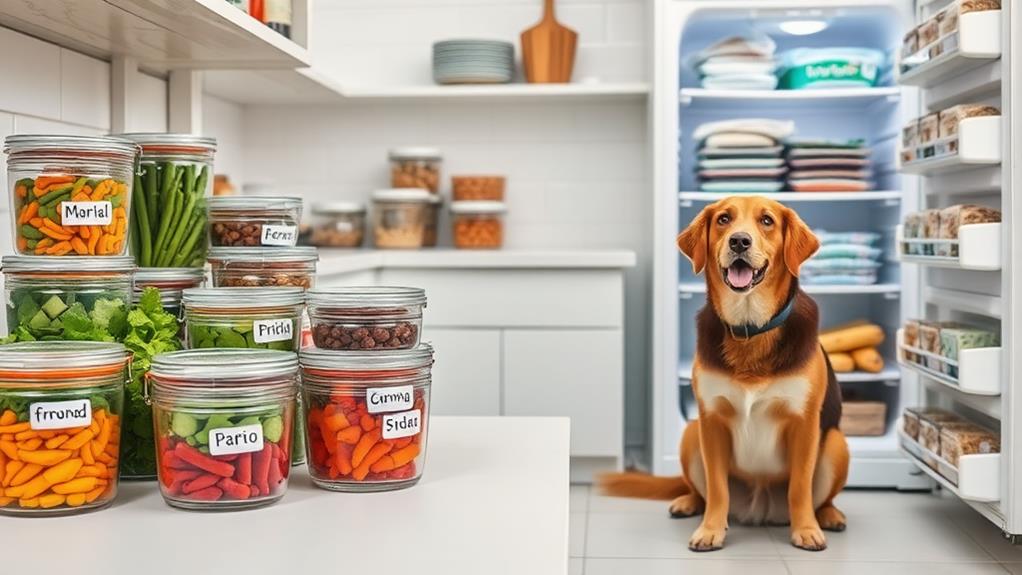
Proper storage is essential to keep your dog's meals fresh and safe. To maintain the quality and safety of your homemade dog food, follow these simple storage tips:
- Use Airtight Containers: Invest in high-quality, airtight containers to prevent air and moisture from spoiling the food. Glass or BPA-free plastic options are great choices.
- Label & Date: Always label your containers with the meal type and the date you prepared it. This helps you keep track of how long the food has been stored.
- Divide into Portions: Consider portioning out the meals before storing. This not only makes it easier to serve but also minimizes the time the food is exposed to air each time you open a container.
- Store in the Right Location: Keep your dog's meals in the refrigerator or freezer, depending on when you plan to use them. For short-term storage, the fridge is ideal, while the freezer is best for longer-term options.
Monitor Freshness and Safety
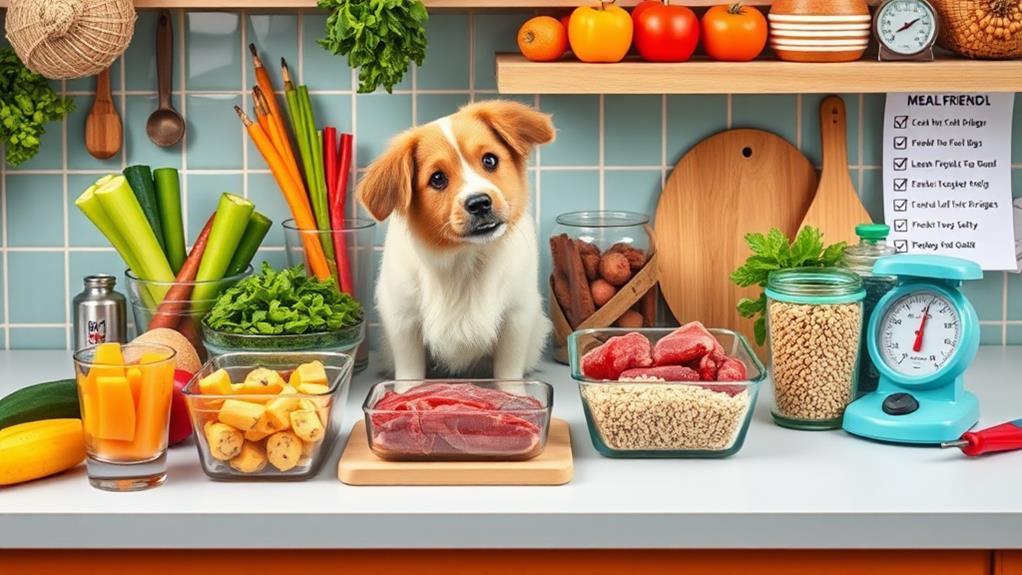
Your dog's health depends on the freshness and safety of their meals, so it's crucial to regularly assess how long the food has been stored. Always check for any signs of spoilage before serving. Look for changes in color, texture, or odor, as these can indicate that the food is no longer safe.
To help you keep track of your dog's meals, consider using the following table:
| Food Type | Recommended Storage Time |
|---|---|
| Cooked Meat | 3-4 days in the fridge |
| Cooked Vegetables | 3-5 days in the fridge |
| Dry Dog Food | Check expiration date |
| Homemade Treats | 1-2 weeks in the fridge |
| Frozen Meals | 3-6 months in the freezer |
Label containers with the preparation date to confirm you're serving fresh food. When in doubt, throw it out. Regularly cleaning your storage area will also help maintain a safe environment for your dog's meals. Remember, your furry friend relies on you to provide safe, nutritious food, so make freshness a top priority!
Adjust for Dietary Restrictions
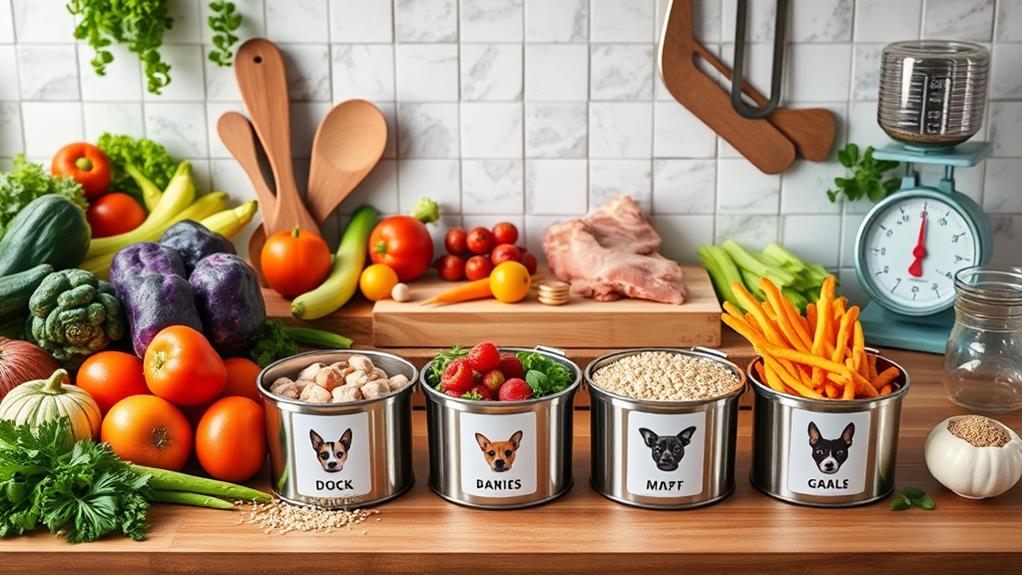
When it comes to meal prepping for your dog, adjusting for dietary restrictions is essential for their health and well-being. You need to ponder specific needs based on allergies, sensitivities, or medical conditions.
- Identify Allergens: Start by figuring out which ingredients your dog can't tolerate. Common allergens include wheat, soy, and certain proteins like chicken or beef.
- Consult Your Vet: Always check with your veterinarian before making any significant changes to your dog's diet. They can provide valuable insights into your dog's specific needs.
- Choose Safe Ingredients: Focus on using fresh, whole foods that align with your dog's dietary restrictions. For example, if your dog is sensitive to grains, consider using sweet potatoes or peas as a carbohydrate source.
- Monitor Reactions: After introducing new foods, keep an eye on your dog for any adverse reactions. A food diary can help track their responses to different meals.
Incorporate Variety in Meals
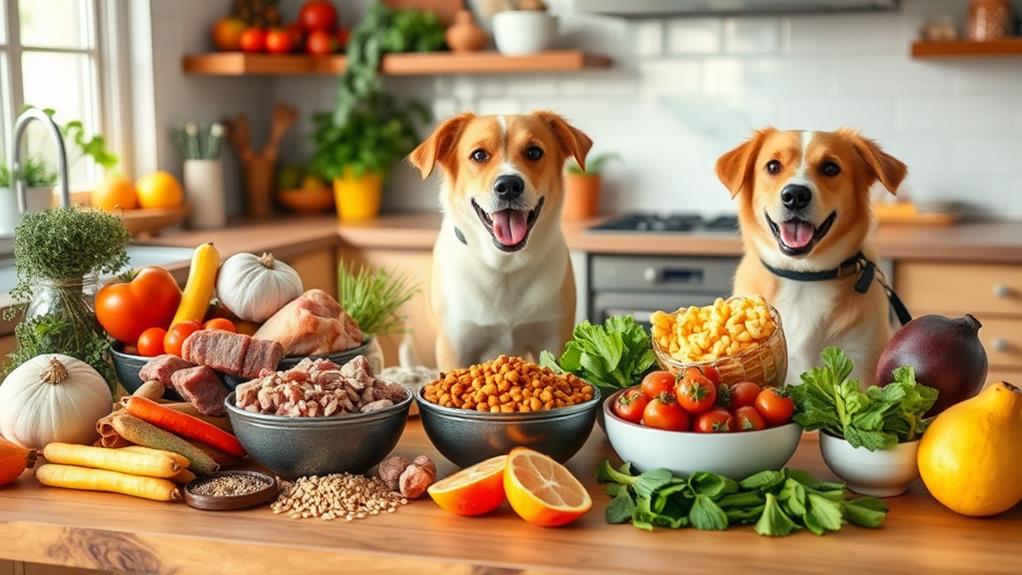
Incorporating variety in your dog's meals is pivotal for keeping them engaged and healthy. Dogs, like humans, can become bored with the same food day in and day out. By mixing things up, you not only keep their interest alive but also provide a broader range of nutrients.
Start by rotating proteins. Chicken, beef, turkey, and fish all offer different benefits. You can also think about plant-based options like lentils and chickpeas for fiber.
Next, add a variety of vegetables. Carrots, green beans, and sweet potatoes can be excellent choices, just guarantee they're safe and cooked properly.
Don't forget about grains! Brown rice, quinoa, and oatmeal can complement their meals and provide energy. You might also consider adding different flavors with herbs like parsley or basil, which can boost taste without harmful additives.
When you prepare meals, consider using different cooking methods too. Steaming, boiling, or baking can change the texture and flavor profile, making meals more enticing. By incorporating variety, you're not only making mealtime fun but also ensuring your dog receives a balanced and nutritious diet.
Evaluate and Adapt Meal Plans
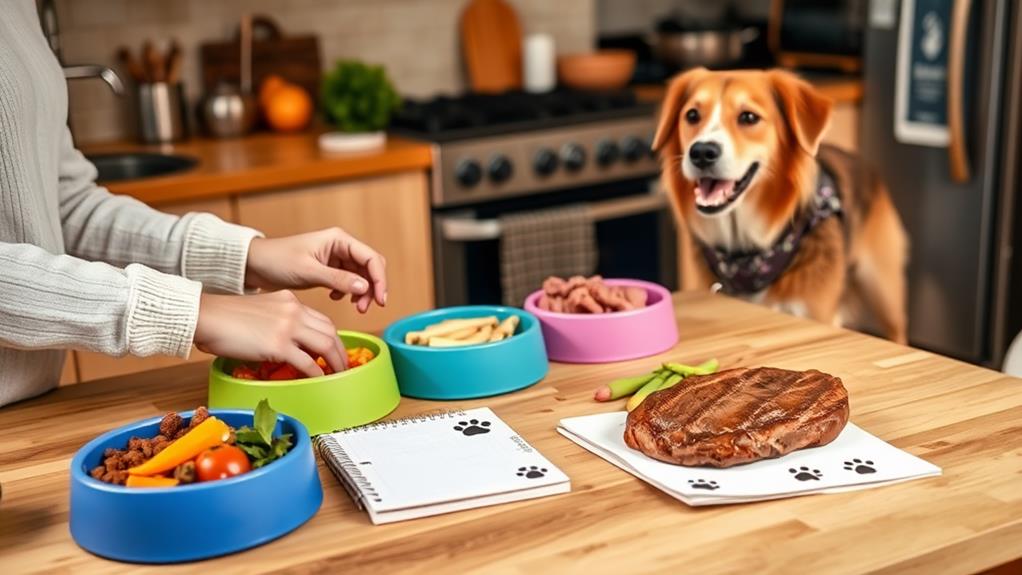
After introducing variety into your dog's meals, it's important to regularly evaluate and adapt their meal plans to meet their changing needs. Dogs can experience shifts in health, activity levels, and preferences, so staying attentive is essential.
Monitor Weight and Body Condition: Keep an eye on your dog's weight and overall body condition. If they're gaining or losing weight unexpectedly, it might be time to tweak their portions or ingredients.
Check for Allergies or Sensitivities: Be vigilant for any signs of allergies or digestive issues. If your dog shows discomfort or unusual reactions, consider replacing certain ingredients.
Consult Your Vet Regularly: Regular vet check-ups can provide insights into your dog's nutritional needs. Your vet can help you adjust meal plans based on health changes.
Observe Their Energy Levels: Pay attention to your dog's energy throughout the day. If they seem lethargic or overly hyper, adjusting their diet can help balance their energy.
Frequently Asked Questions
Can I Feed My Dog Raw Food While Meal Prepping?
Yes, you can feed your dog raw food while meal prepping. Just guarantee you're balancing nutrients and maintaining proper hygiene to avoid contamination. Consult your vet to confirm it suits your dog's specific health needs.
How Do I Transition My Dog to Homemade Meals?
To shift your dog to homemade meals, start gradually mixing small amounts of the new food with their current diet. Increase the homemade portion over time, ensuring your dog adjusts well without digestive issues.
What Kitchen Tools Are Essential for Dog Meal Prepping?
For effective dog meal prepping, you'll need a good knife, cutting board, measuring cups, food processor, and storage containers. These tools help you prepare, portion, and store your dog's meals efficiently and safely.
Are There Specific Foods I Should Avoid for Dogs?
Did you know that over 90% of dog owners unknowingly feed their pets harmful foods? You should avoid chocolate, grapes, onions, and xylitol. These can seriously harm your dog's health, so always check ingredients carefully.
How Can I Accommodate My Dog's Allergies in Meal Prep?
To accommodate your dog's allergies in meal prep, identify the allergens and avoid them in recipes. Use fresh, whole ingredients and label everything. Consult your vet for tailored advice to guarantee your dog's health.
Conclusion
By embracing these meal prepping tips, you're not just feeding your dog; you're nurturing their health and happiness. Think of it as crafting a culinary symphony, where each ingredient plays a crucial role in your pup's well-being. Stay attentive to their needs, and adapt as necessary, ensuring every bowl serves as a tribute to your love. With a little planning and creativity, you'll transform mealtime into a delightful experience for your furry friend.

